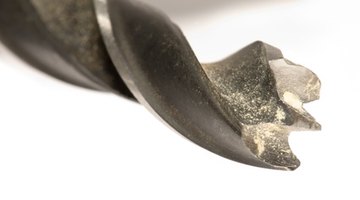My Post Hole Digger Won't Dig
A tool as simple as a post hole digger should work. And when a manual post hole digger won't work, it should be easy to switch to a mechanical one, commonly known as an earth auger. But dirt isn't always dirt; more often it is decomposed granite or rocks -- big and small. Your blades have to be sharp and your shoulders strong and it's still part of the deal that your post hole digger won't always dig.
Manual post hole digging

-
Sharpen your blades. There's a good chance that a manual post hole digger came to you unsharpened. Stores often keep their stock unsharpened for safety and may not tell you if it's pre-sharpened. Check each blade for a shiny bevel. If you've been using it and it isn't biting the earth aggressively, it could have become dull from use. Either way, take a coarse file to it. You want to sharpen the concave digging edge, like a shovel. Move the file in one direction, away from you across the edge, about ten times on each blade. You can see the bevel as it appears. Do more passes if it started out very dull. Just like shovels, the post hole digger, which is really two shovels hinged together, needs upkeep.
-
Tear the grass and weeds out first. Even with newly sharpened blades, the digger can still be stopped by thick wet grass which mats and doesn't slice easily. The digger can also be stopped by the earth if it is rock-like or decomposed granite. In those instances, you may only get one hole dug before you'll have to sharpen both sides again. Carry your file with you. It also helps to put a slow running hose on a particularly stubborn piece of earth for a couple of hours.
-
Hold the two upright handles about six inches apart when you plunge them into the earth. Then, pull them all the way apart to capture the dug earth to bring it up and out of the hole. Reposition them 6 inches apart and plunge again. With sharpened blades and softened earth you should be able to make some headway.
Mechanical post hole digger or earth auger
-
Try an earth auger. The hole digger with a power head is heavy, serious and only seems like it's going to dig smoothly. You'll expect to whip out a bunch of holes in an afternoon. Chances are you rented one of these because the manual ones aren't as easy as they look. These aren't either.
-
Take precautions. An earth auger is a powerful tool, even the moderate-sized ones. And, as mentioned above, if it gets stuck in the hole and won't turn, you turn instead.
Question the rental place. Has the blade been recently sharpened? Look at the bevel to be sure. A telltale sign of a newly sharpened edge is shiny metal, but even if the auger was used for a couple of jobs, it could be sharp enough.
-
Give yourself a good start. Use a shovel to dig a starter hole about 4 inches deep. Put the auger in and turn it on. Within the hole the tip can't bounce away from you the way a drill will on some wood. Be careful; it is a powerful tool. As you get the hang of it, dig down about four inches, reverse the throttle to reverse out the earth and then dig another four inches, going at it slowly. The power of the auger will tempt you to keep going straight down, but do not. The deeper the hole goes without reversing out the earth, the greater the possibility it will get stuck and won't dig.
Backing the auger out if it won't go forward or backward is a terrible job. You'll have to remove the power head and take a pipe wrench to back the bit out.
-
Soak the hole with water. The auger may also stick every now and again. It may be giving you warning that it's encountering resistant rock or some composition of dirt and pebble. If that happens, back it out and soak the hole with water. If you are digging in more rock than dirt, the water takes longer to soak in. You can start to dig when the water is mostly absorbed.

References
Tips
- The best option is to be approximate about your fence pole positions. A straight fence is visually appealing, but if it's easier to dig a foot off the straight line, the fence will be just as appealing after plants and grasses disguise it.
Warnings
- It can't be repeated enough. Take care with the torque of the mechanical post hole digger. You can learn how to harness the power, but it's startling at the beginning.
Writer Bio
Judith James started writing in the 1970s for "Cosmopolitan," "New West" and the "Los Angeles Herald Tribune" on hardware stores, women's issues and California water. In 2006 she became editor of the Women in Film online magazine writing on hybrids and the greening of production. She is also a film, television and stage producer. James received a Bachelor of Arts in theater from Vassar.
Photo Credits
- post hole digger image by Joann Cooper from Fotolia.com
- auger image by Aleksandr Ugorenkov from Fotolia.com
More Articles



